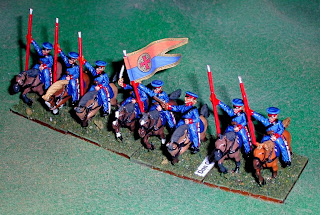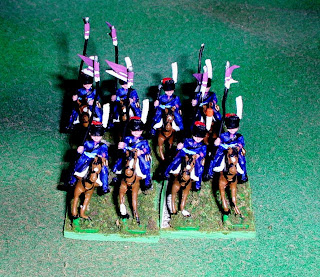As most wargamers are aware, the Russian army of this era had a particular fondness for the artillery arm. According to Nafziger, "their artillery was highly professional and well trained. It received special consideration and the finest horses available." The Russian ordnance was redesigned and standardized by Arakcheev in 1805, and in 1811, the Karbanov gun-sight systems were installed. The Russian guns also used an elevating wedge adjusted by screws, an improvement over the plain wedges used elsewhere. Unfortunately, it seems that the quality of Russian gunpowder may not always have been equal to the caliber of its Artillery personnel and equipment.
Russian batteries were larger than those of other nations, consisting of eight long guns (6lbers or 12 lbers depending upon the battery) and four Licornes (20 pounders for the heavy batteries, and 10 pounders for the rest). Licornes were a kind of long barrelled howitzer unique to the Russian Artillery that had improved range and accuracy over conventional howitzers (although would suspect, perhaps someone less suitability for indirect fire). A Battery was organized into two six gun half batteries. Unlike most other armies of the era, the train personnel were integrated into each artillery company, separate train companies not being formed until 1819.
The first Russian Horse Artillery companies were formed in 1794. In 1802, the Horse Artillery adopted uniforms in the same general cut as the Dragoons, and they adopted helmets of the same style as the Dragoons and Cuirassiers in late 1803. Their jackets were dark green, with black turnbacks, collars and cuffs, piped red. Shoulder straps were red for the first battalion (of 5 companies each), and white for the second. The colors of shoulder straps changed by company with the dissolution of the HA Battalions and distribution of the individual HA companies to the various brigades in 1807 (see Viskovatov), before becoming universally red in 1808.
Russian batteries were larger than those of other nations, consisting of eight long guns (6lbers or 12 lbers depending upon the battery) and four Licornes (20 pounders for the heavy batteries, and 10 pounders for the rest). Licornes were a kind of long barrelled howitzer unique to the Russian Artillery that had improved range and accuracy over conventional howitzers (although would suspect, perhaps someone less suitability for indirect fire). A Battery was organized into two six gun half batteries. Unlike most other armies of the era, the train personnel were integrated into each artillery company, separate train companies not being formed until 1819.
The first Russian Horse Artillery companies were formed in 1794. In 1802, the Horse Artillery adopted uniforms in the same general cut as the Dragoons, and they adopted helmets of the same style as the Dragoons and Cuirassiers in late 1803. Their jackets were dark green, with black turnbacks, collars and cuffs, piped red. Shoulder straps were red for the first battalion (of 5 companies each), and white for the second. The colors of shoulder straps changed by company with the dissolution of the HA Battalions and distribution of the individual HA companies to the various brigades in 1807 (see Viskovatov), before becoming universally red in 1808.
Here is a fine line of unlimbered Russian Horse artillery preparing to open fire. The trumpeters had red crests on the helmet, as in the Dragoons, and would have had white lace on the sleeves in full dress as well, again the same as for the Dragoons. In full dress their pants would be white, but here they are shown wearing the grey service overalls. These are 25/28mm Old Glory crew figures with the great Sash and Saber guns.
Another view of the Horse Artillery. Additional minor uniform details include red cords on the the brass trumpets, and saddle cloths dark green with a yellow border and imperial cypher (A-1) in the rear corners. Bombardiers, being Corporals, had gold galloons on the cuffs, while Fireworkers and 1st Sergeants had them on both the collars and cuffs. Buttons were brass/gold for all.
The front portion of the crests were white with an orange stripe for NCO's; officers' crests were white on the top and black on the bottom, separated by a thin orange stripe. I'll have to paint a few figures with these colorful crests for added interest! By the way, we use the markers behind the guns to indicate "suppressed" status in the Field of Battle rules.
A final view of the Horse Artillery in helmets; the crests changed from a fat caterpillar type to the thin brush-like ones seen here in 1808, the same time as they changed for the Dragoons and Cuirassiers as well. These units were painted in late 2010 (I use two stands for each battery in my armies, each with 1 gun and three crew (four crew for heavy batteries), which happens to fit in nicely with the Field of Battle rules as well.
In 1814, the Horse Artillery adopted uniforms in the style of the Mounted Jagers, including the Kiwer, but in this case with red cords and pom-poms, and white plumes for the men. Cords were mixed black, white, and orange for under officers, and silver for officers. Plumes were red for trumpeters, white with a black tip and thin orange line between for NCO's, and white with a black and orange base for company grade officers.
These Minifigs (both guns and crew) also show the new dark green pants with a double red stripe down the seam that was also adopted in 1814. The coat also became single breasted, as opposed to the earlier double breasted jackets. I'm not sure if the red borders to the saddle blankets shown here is correct, or if they were still yellow; I painted these guys many years ago, when all I had to go by was Funken and Knoetel!
Russian Artillery carriages are described as being painted "apple green", which would imply a somewhat lighter color than I have used, but most pictures that I've seen of Russian Artillery show a similar dark green shade. Like my French Horse Artillery units, the mounted crewmen, here using Mounted Jager figures, make it obvious this is a HORSE battery! I could have done the thing with the Old Glory units, using Old Glory mounted Dragoons figures... but I was too cheap to do so! :-)
A final view of the Horse Artillery in their more modern looking 1814 uniforms. Once again the Minifigs haven't held up all that badly 30 years later!
I gave this stand the black tipped plumes of NCO"s (I'll have to add the thin orange stripe) to make it stand out, and call it my Guard unit. Otherwise the only other real distinction would be the gold Guard litzen on the collars and cuffs, which is pretty subtle!
A close up view of this single stand...
and another!
A Limbered Russian gun. Properly speaking there should be 4-6 horses per gun, but frankly that takes up way too much space on the tabletop for my tastes, so I just use the single pair.
The integral train personnel of each company worse the same uniform as the artillery, but with grey trousers as their only distinction
What to do with extra crew figures? Make some Engineer units! These are admittedly pretty crude minor conversions. Still, just what your Russian Army needs to dig in, eh?
There were eventually 2 regiments each of Miners and Sappers. Their overall uniform was similar to that of the Artillery. Yellow pom-poms denote the sappers, and red the miners. Both had white metal/silver buttons. Further details, if needed, can be found in Viskatov once again (translation by Mark Conrad).
I again used NCO plumes for my "Guard" sapper company to make it easy to identify them on the tabletop, if not strictly historically accurate.
Until next time... keep your powder dry!
Peter




















































